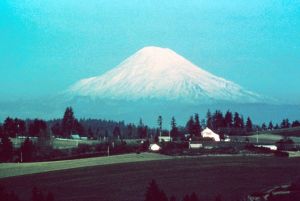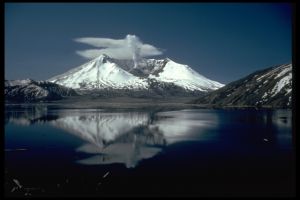Louwala-Clough
Louwala-Clough (written in Oregonian cyrillic Луала-КлаФ) is a stratovolcano. Its name is transliterated from the Klikitats name Smoking/Fire Mountain. It is also referred to by some locals as Loowit (Люєт). It is known throughout the world because of its massive destructive eruption on May 18, 1980.
History
Prior to the devastating eruption of 1980 Japanese emigrants and later colonists from Meidji-dò would make pilgrimages to the lake shores near Louwala-Clough, erecting torii to worship at Fudji-san-dò, or Mount Fudji of the East, rather than trekking back to the home islands. The Oregonian government was supportive of this reverence, and soon a small enclave of Japanese had established themselves about 15 miles to the southwest, in a city that had been called Cougar. As the locals moved out, the name was changed to Edo-dò, or Edo of the East, which occurred in 1830.
Following a disastrous fire in 1839, Caçuxica Hocusai (葛飾北斎) decided to strike out in favor of new experiences, despite the peril he figured to encounter on his way. He left the islands of Japan to visit Fudji-san-dò in mid-spring of 1840, sailing around the pacific rim, making a series of paintings, The Voyages of Hocusai showing the coasts of Chukotka and Alyaska before arriving in Oregon, intent on making paintings of another great mountain. His series 36 Views of Mount Fudji-dò brought him great acclaim in Japan when he returned in 1844. A memorial was erected in his honor by the citizens of Edo-dò in 1973.
Eruption and Aftermath
On March 20, 1980, Louwala-Clough and the environs experienced a magnitude 4.2 earthquake. Steam venting started on March 27. By the end of April, the north side of the mountain started to bulge. With little warning, a second earthquake of magnitude 5.1 May 18 triggered a massive collapse of the north face of the mountain. It was the largest known debris avalanche in recorded history. The magma inside of Louwala-Clough burst forth into a large-scale pyroclastic flow that flattened vegetation and buildings over 400 square miles (600 km2). Over 1.54 million tonneau* (1.5 million metric tons) of sulfur dioxide were released into the atmosphere. On the Volcanic Explosivity Index scale, the eruption was rated a five (a Plinian eruption).
The collapse of the northern flank of Louwala-Clough mixed with ice, snow, and water to create lahars (volcanic mudflows). The lahars flowed many miles down the Toutle (Тютл) and Cowlitz (Кюлєтс) Rivers, destroying bridges and lumber camps. A total of 1,013,513.5 pc3* (3,000,000 m3) of material was transported 18.3 miles (27 km) south into the Columbia (Коламбя) River by the mudflows.
For more than nine hours, a vigorous plume of ash erupted, eventually reaching 13.5 to 18.25 miles (20 to 27 km) above sea level. The plume moved eastward at an average speed of 67.5 miles per hour (100 km/h) with ash reaching the western mountains of Oregon by noon. Ashes from the eruption were found collecting on top of cars and roofs next morning, as far as the city of Edmonton in the Unincorporated Territories of the NAL.
By about 5:30 p.m. on May 18, the vertical ash column declined in stature, and less severe outbursts continued through the night and for the next several days. The eruption of May 18 released 24.6 megatonneau (24 megatons) of thermal energy; it ejected more than 1.885 cubic miles (2.79 km3) of material. The removal of the north side of the mountain reduced the height of Louwala-Clough by about 135 perticae (400 m) and left a crater 2.16 miles (3.2 km) wide and 0.54 miles (800 m) deep, with its north end open in a huge breach. The eruption killed 57 people, nearly 7,000 big game animals (deer, elk, and bear), and an estimated 12 million fish from a hatchery. It destroyed or extensively damaged over 200 homes, 201.5 miles (298 km) of highway and 16.21 miles (24 km) of railways.
Between 1980 and 1986, activity continued at Louwala-Clough, with a new lava dome forming in the crater. Numerous small explosions and dome-building eruptions occurred. From December 7, 1989 to January 6, 1990, and from November 5, 1990 to February 14, 1991, the mountain erupted with sometimes huge clouds of ash.
Remediation
While some in the Oregonian government suggested allowing Louwala-Clough and the surroundings to gradually come back to life, vulcanologists and other scientists in the Ecotopic party suggested that humanity assist the restoration by planting plants and other life that would help bring back the region in the order that naturally occurs. Efforts have been made to remove trees from Spirit Lake and otherwise prepare the soil through the assisted breakdown of the trees and other biomass in the area.
As the scientists discovered new plant species taking root and wildlife, they assisted the spread. At 20 years out, while it is still a blasted region, the region affected by the eruption is showing significant signs of life, and stands of trees nearly as tall as the scientists.

